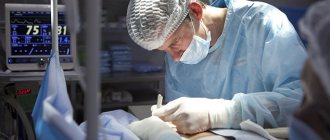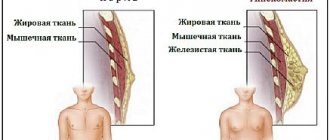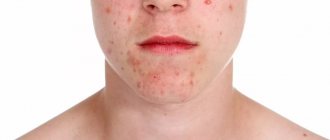Gynecomastia in men is a disease based on unilateral or bilateral enlargement of the mammary glands. The disease can progress both against the background of hormonal disorders and in relatively healthy men who do not have problems with hormones, but are obese.
There are two forms of gynecomastia in men: physiological and pathological. The physiological variant of breast tissue enlargement occurs in newborns and adolescents, as well as in older people, in whose body the level of testosterone sharply decreases and female sex hormones - estrogens - begin to predominate. Gynecomastia during the newborn period occurs due to the influence of maternal hormones that reach the child in utero.
During puberty, many adolescents suffer from bilateral breast enlargement, which usually goes away on its own without any treatment. The problem is associated with changes in hormonal levels, namely with an increase in the amount of estrogens and their predominance over male sex hormones.
In most cases of gynecomastia in men, there is a bilateral increase in the volume of the mammary glands. At the CONSTANTA Clinic you can seek qualified medical care, make an appointment with experienced specialists who will conduct a comprehensive diagnosis and determine the true causes of the disease. Doctors will develop individual treatment tactics for gynecomastia, in accordance with the diagnostic data obtained and the general well-being of the patient. Read more about the treatment of gynecomastia in men in our Clinic.
The main reasons for the development of gynecomastia in men
Normally, the mammary glands in men and adolescents are underdeveloped, formed by a small amount of glandular tissue. With obesity, adipose tissue begins to predominate. Breast volume is determined by the influence of female sex hormones - estrogens, as well as prolactin - a pituitary hormone. When, for various reasons, the androgenic index decreases and the amount of estrogen increases, excessive growth of the mammary glands in men is observed according to the female type with a predominance of glandular cells.
Unlike physiological gynecomastia in men, which is considered a passing phenomenon and in most cases resolves on its own, the pathological form of the disease is often associated with organic pathology and serious internal disorders. It is often necessary to involve highly specialized specialists in treatment: therapists, endocrinologists, oncologists, surgeons.
The main causes of true pathological gynecomastia:
- a similar condition is typical for neoplasms of the pituitary gland and testicles, primary hypogonadism, prostate adenoma and other hormonally active tumors;
- an increase in the amount of prolactin - increased secretion is associated with neoplasms of the pituitary gland and a lack of thyroid hormones;
- treatment with drugs that stimulate the synthesis of estrogen and prolactin;
- taking steroids;
- infectious and inflammatory processes, immunodeficiency states;
- chronic intoxication;
- excess body weight;
- liver and kidney diseases;
- diseases that are accompanied by metabolic disorders and dysfunction of the endocrine glands.
Drug addiction has an extremely adverse effect on the condition of the liver and mammary glands. Potent drugs, especially the opiate group, help increase the synthesis of prolactin, disrupt the functional abilities of the liver, disrupt the course of metabolic reactions, change the condition of the gonads and reduce the amount of testosterone produced. All this increases the synthesis of female sex hormones and leads to the development of gynecomastia.
Etiology
Literally translated from Latin, “gynecomastia” means female breasts. The pathology is observed in men and has the appearance of a benign formation, the structure of which is formed due to the cells and ducts of glandular tissue or the growth of the fat layer. In the first case, they talk about the so-called true gynecomastia, and in the second, about a false type of disease. The increase can reach 12 cm, which causes the patient severe psychological discomfort and significant inconvenience in everyday life. Unilateral enlargement of the glands is rare; more often the disease affects both glands. Externally, it manifests itself in the form of sagging tissues, reminiscent in shape of a woman’s breasts.
Main symptoms of gynecomastia
The main sign of the development of gynecomastia is excessive growth of the mammary glands. As a rule, in men there is an increase in predominantly glandular tissue. When the amount of fatty tissue in the breast area increases, experts diagnose pseudogynecomastia. In addition to the appearance of mammary glands that are not typical for the male constitution, other signs of the disease may be present:
- pathological discharge from the nipples;
- pain in the chest area;
- increased nipple sensitivity;
- thickening of breast tissue;
- discomfort when the chest rubs against clothing.
If pathological growth of the mammary glands is detected, it is necessary to contact a specialist as soon as possible. Only doctors, having wide diagnostic and treatment capabilities, can make an accurate diagnosis and select an effective treatment regimen for gynecomastia in a man. Specialists are especially wary of unilateral enlargement of the mammary gland, which can be observed with the development of malignant pathology, as well as the appearance of bloody discharge from the nipple and suspicious lumps. Sometimes, against the background of male gynecomastia, the axillary lymph nodes become enlarged, which can also be considered an alarming symptom that requires consultation with a doctor and a detailed examination of the mammary gland and surrounding tissues.
Which doctor should I contact?
In order not to seriously worsen your health, it is better to consult with a specialist about which drug causes gynecomastia, the advisability of its use, and you can also be under the supervision of a specialist while taking this type of drug.
An endocrinologist deals with changes in hormonal levels in the body and treatment of hormonal dysfunction.
I, Romanov Georgy Nikitich, am an experienced specialist in the field of endocrinology, I have extensive experience working with athletes who take or have taken steroid drugs. As a specialist, I have more than 20 years of work experience, received a Candidate of Medical Sciences degree, and manage a private clinic.
Anyone can sign up with me for a paid in-person or online consultation, where I will consider your situation, help you make a diagnosis, prescribe treatment and monitor this process.
You can sign up on one of the social networks or messenger listed on this page.
Examination for gynecomastia
To make a preliminary diagnosis, the doctor only needs to conduct a standard examination and palpation of the breast tissue and nearby lymph nodes. But an accurate diagnosis of gynecomastia is carried out only on the basis of the results of modern research. Ultrasound is considered the main diagnostic method. Specialists conduct ultrasound examinations of the mammary glands, scrotal organs, and axillary lymph nodes.
Laboratory tests are actively used, which include determining the level of testosterone, hCG, estradiol and prolactin, as well as other hormones (as indicated). If the development of a malignant tumor is suspected, a breast biopsy is prescribed. Additionally, magnetic resonance imaging and computed tomography of internal organs are used.
At the CONSTANTA Clinic, patients have access to many types of modern diagnostic and laboratory tests, which allow them to obtain the most reliable information about the patient’s condition and the functioning of all his internal organs, including the endocrine glands. We provide professional assistance to men with gynecomastia and provide both symptomatic and surgical treatment.
Gynecomastia is a serious disease that requires an integrated approach and the participation of experienced specialists. Delayed visit to the Clinic or the use of questionable home methods for treating gynecomastia in men can lead to the development of serious complications. Our specialists have modern therapeutic and surgical methods to combat this disease, which are highly effective and safe. You can discuss treatment options with your doctor. Do not hesitate to ask a specialist any questions that interest you. The doctors of the CONSTANTA Clinic are focused on respecting the interests of their patients and maximum concentration of professional forces on solving the problems of each patient.
Diagnostics
Characteristic external symptoms allow the doctor to accurately make a diagnosis and prescribe additional measures to clarify the nature of the disease. You can get a comprehensive picture:
- interviewing the patient with a request to describe his own feelings and complaints of malaise;
- external examination of the mammary glands with palpation of the contents, as well as studying the condition of other organs, signs of pathology of which can be detected visually;
- biochemical blood test for gynecomastia, on the basis of which the doctor can easily determine the fact of hormonal imbalance;
- mammography, the image of which clearly shows the structure of the tissue and the features of its development;
- computed tomography and magnetic resonance imaging, thanks to which it is possible to determine the cause of development and the type of overgrown tissue;
- biopsy of overgrown tissues with their mandatory histological examination, necessary for the timely detection of a malignant process.
The sooner the correct diagnosis is made to the patient, the greater the chance of achieving significant treatment results and completely eliminating the external manifestations of the pathology.
Gynecomastia and steroids
Taking anabolic steroids often leads to the development of male gynecomastia. Steroid hormones contribute to the excessive formation of female sex hormones, in particular estradiol. As a result of long-term use of anabolic steroids by athletes, female-type adipose tissue deposition and bilateral enlargement of the mammary glands are observed. Athletes taking steroids should take care in advance to prevent gynecomastia. It involves taking special medications that block estrogen receptors. Ideally, an athlete’s career should be built without the use of steroid drugs, which have a detrimental effect not only on hormonal status, but also on the entire male body.
How to avoid gynecomastia on the course
There are several rules that must be followed during the course, however, the appearance of gynecomastia largely depends on a person’s genetic predisposition.
Let's consider the basic rules that must be followed to prevent the occurrence of the disease:
- proper balanced diet - you need to saturate your body with useful micronutrients, maintain the norm and proportions of proteins, fats and carbohydrates;
- before taking medications, it is best to exclude deficiency conditions in the body;
- a well-designed training program, that is, all loads should be normalized and there should be no serious jumps, then the body gets used to it faster and no serious hormonal disruption occurs;
- There are special drugs that to some extent block the adverse effects of steroids, however, they also have their own side effects and the appropriateness of their use is considered by the doctor based on the patient’s medical history.
Gynecomastia in endocrine pathologies
Endocrine diseases often cause the development of gynecomastia in men. Various pituitary tumors lead to hyperprolactinemic hypogonadism. In this condition, the synthesis of gonadotropins and testicular function are impaired, and spermatoginesis may decrease. As a result, men note a decrease in potency and disappearance of libido. Adolescents in this state do not have clearly expressed secondary sexual characteristics.
Hyperprolactinemia is observed with the growth of prolactinoma, as well as with other pituitary adenomas and the presence of hormonally inactive adenomas. In childhood, gynecomastia can occur with hyperthyroidism. Thyroid hormones help increase estradiol levels. To get rid of gynecomastia caused by hyperthyroidism, it is first necessary to treat the underlying disease.
Gynecomastia and genetic pathologies
Genetic abnormalities often underlie the development of gynecomastia. Most often, excess growth of breast tissue is diagnosed in men with Klinefelter syndrome, in which an extra X chromosome is detected in the cells. These men have increased sensitivity to estrogen. With this disease, hyperprolactinemia occurs, which also increases the manifestations of gynecomastia.
In Klinefelter syndrome, puberty may occur on time, but puberty is often delayed. Patients exhibit predominantly tall stature and abnormal physique, in which the lower part of the body is significantly larger than the upper part. The size of the testicles is reduced. For chromosomal abnormalities, treatment of gynecomastia is predominantly surgical. The nodular form of the disease requires constant medical supervision and a biopsy after surgery or at the diagnostic stage.
Reifenstein syndrome occurs with increased estrogen synthesis and the development of gynecomastia. Symptoms of the disease usually appear during adolescence, when hormonal changes in the body occur. At the same time, experts identify signs of underdevelopment of the genital organs. Such patients require hormone replacement therapy with individual dosage selection.
True hermaphroditism also occurs with symptoms of gynecomastia. The patient usually learns about his problem at the beginning of puberty, when active growth of the mammary glands begins and other signs of the formation of a female-type figure appear.
Causes of the disease
The main reason is hormonal imbalance. It occurs due to the following factors:
- Congenital testicular underdevelopment
- Testicular damage due to radiation or infection
- Testicular tumor
- Disruption of the hypothalamus, which is responsible for the production of hormones
- Thyroid problems (thyrotoxicosis)
- Pathology of the liver when it stops destroying the female hormone estrogen
- Klinefelter syndrome (chromosomal pathology in which a boy has several female chromosomes)
- Kidney failure
- HIV infection
- Hyperprolactinemia
- After reducing intense sports loads
But gynecomastia can be a consequence of a side effect when taking certain medications:
- some antibiotics and antibacterial drugs
- diuretic
- antidepressants
- therapy for HIV infection
- hormonal drugs prescribed for prostate cancer
- antiulcer drugs
- drugs to treat high blood pressure
- corticosteroids
Only some of the tablets from the above drugs can have a side effect in the form of gynecomastia. You can check this with your doctor, and if this happens, he will decide to replace the drug, if possible.
Gynecomastia and liver diseases
Some liver pathologies can lead to the development of gynecomastia. Important metabolic processes occur in the liver tissues. This organ is responsible for the metabolism of steroids. Therefore, if its work is disrupted, with the development of hepatitis, alcoholic cirrhosis, the risk of mammary gland growth in men increases. Specific kidney enzymes lead to the destruction of prolactin and gonadotropins, as well as slowing down the release of body tissues from metabolic products. All this often leads to an increase in the level of prolactin and estrogen, causing the progression of gynecomastia.
Gynecomastia and breast neoplasms
Tumors in the mammary glands are often mistaken for true gynecomastia. The process is most often one-sided, but sometimes the neoplasms involve two mammary glands at once. To the touch, the tumor has a dense consistency, is usually fused with adjacent tissues and has unclear contours. With breast tumors in men, bloody discharge from the nipples may appear, and sometimes the lymph nodes in the armpit become noticeably enlarged.
When a tumor is detected, specialists refer the patient for mammography, ultrasound, MRI and prescribe a biopsy, based on the results of which they can determine the nature of the tumor and make appropriate predictions for the future.
Iatrogenic gynecomastia
Iatrogenic gynecomastia occurs when taking certain medications. The risk group includes patients who undergo hormonal treatment with estrogens, as well as other hormones (gonadotropins, glucorticoids). Against the background of hypogonadism, specialists often prescribe testosterone, which is toxic to the liver and can cause signs of temporary gynecomastia. Cardiac glycosides have a similar effect, stimulating the active production of steroids and disrupting the functional abilities of the testicles.
Drug-induced gynecomastia is most often a reversible process that can be stopped after stopping the medication that caused excessive breast growth. But it is necessary to stop taking medications as soon as possible. If you do not pay attention to the appearance of gynecomastia during drug therapy for 6-12 months or more, irreversible fibrotic processes will begin to occur in the breast tissue. The advanced form of the disease is subject to predominantly surgical treatment.
Principles of treatment of gynecomastia
Treatment of gynecomastia in men can be therapeutic and surgical. The physiological form of the disease in adolescents and newborns usually disappears spontaneously and does not require specific therapy. According to indications, specialists can carry out hormonal correction with drugs that reduce the level of female hormones. But any medications used to treat gynecomastia in men should only be prescribed by qualified specialists who are familiar with your clinical case. Self-administration of medications, without studying hormonal status and diagnostic results, can lead to adverse health consequences and increased symptoms of the underlying disease.
Conservative therapy for gynecomastia consists of prescribing hormonal drugs containing testosterone. Such drugs are effective in the initial period of development of the disease, in the first months, when scarring and other complications requiring surgery have not yet occurred.
The severe form of gynecomastia does not respond well to conservative treatment. It is extremely important to seek medical help promptly when drug therapy can be highly effective. If the doctor recommends surgical treatment, you should not refuse it. Today, men with gynecomastia have the opportunity to undergo minimally invasive surgical interventions, which do not leave rough keloid scars in the mammary glands. These are the types of operations that are performed at the CONSTANTA Clinic. Excess tissue is removed through a subareolar approach or using an endoscopic method with access from the armpit. In the second case, absolutely no scars remain on the skin of the breast.
For false gynecomastia, liposuction is indicated. The surgeon sucks out excess fat through small punctures in the skin or removes it using the classic surgical method. The operation is performed under general or local anesthesia, depending on the patient’s condition and his wishes.
What should you consider after surgery?
Liposuction for gynecomastia is performed under local anesthesia. The sensations can be compared to anesthesia in the dentist's chair - the patient is conscious, but does not feel pain. This operation is performed on an outpatient basis - the patient spends several hours in the clinic under observation, and then goes home. Intravenous anesthesia may also be used.
Rehabilitation after surgery takes 2 weeks. An important step is wearing a compression bandage. This is important to reduce the risk of swelling and stabilize the result.
The patient will be able to evaluate the final result 1 month after the operation.
Preparation for surgical treatment of gynecomastia in men
No complex preparatory activities are carried out. The patient undergoes a comprehensive examination, which allows him to assess his health condition and choose the appropriate tactics for surgical intervention. Based on the diagnostic data, the doctor makes predictions for the future and selects the correct treatment regimen that prevents the development of complications, both during surgery and in the postoperative period.
The operation is performed on an empty stomach. The doctor will tell you in detail about the features of the surgical stage and recovery period. You must strictly follow your doctor’s prescriptions; if you have any questions or feel unwell, it is recommended that you contact your doctor without delay.
Recovery period after surgical treatment of gynecomastia
In most cases, surgical treatment of gynecomastia in men proceeds without complications. As a rule, long-term hospitalization is not required. The patient is discharged home, given detailed recommendations about the rules of behavior and the prevention of complications.
Gynecomastia in men can develop due to many endocrine and non-endocrine pathologies, so treatment should primarily be aimed at the cause of increased estrogen levels and excessive growth of mammary gland tissue. Medical tactics must be strictly individual. It is necessary to determine the factors that provoke the development of the disease in order to eliminate their adverse effects on the male body. Then both drug and surgical treatment will be highly effective, and the risk of recurrence of the disease can be minimized.
If you have any questions or make an appointment with a specialist, please call: (4852) 37-00-85 Daily from 8:00 to 20:00
Sign up for a consultation










